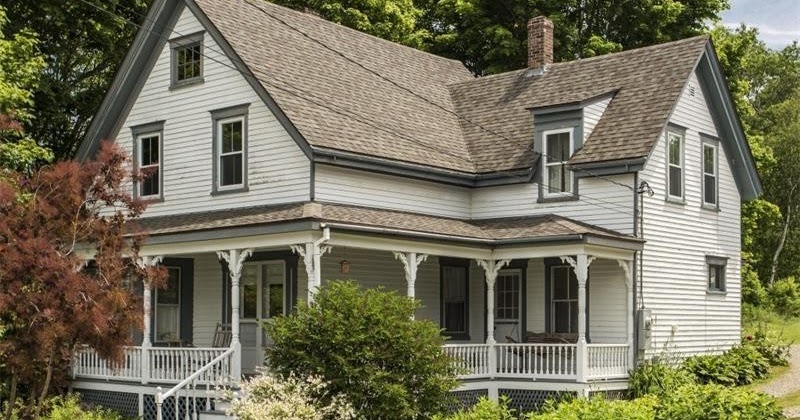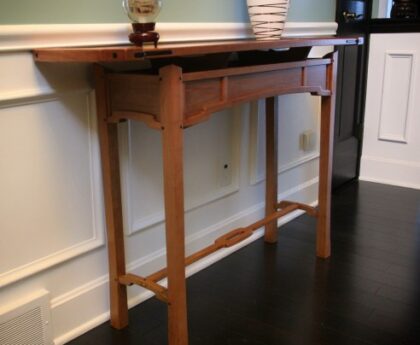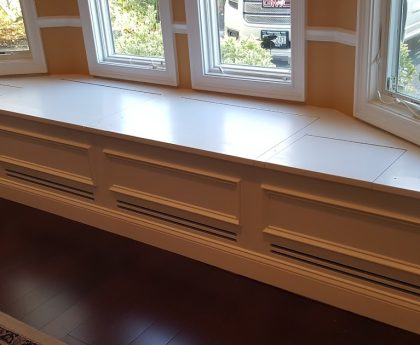The house in East Boothbay.
Life has been busy, busy, busy lately. Hence the lack of posts here.
My shop time has been occupied teaching individual classes. That’s produced good material for some upcoming technique blog posts.
A Place To Build Boats
The next step in the journey is the other big thing occupying my time, a place to build boats. That place is in East Boothbay, Maine, where my mother-in-law has now bought a house. She’ll live there in the warm months, then with us in the cold months. Meanwhile, we’ll spend weekends and vacations there. Eventually, we’ll retire there permanently.
They’ve been building ships and boats there since the 1700’s. Two small yards are still active, Hodgdon Yachts, America’s oldest boat builder, building high-end sailing and motor yachts, and Washburn & Doughty, building commercial tugs and fireboats.
So near water, check. About 100 yards from house to ramp. The river is visible past the Washburn & Doughty buildings. Their launchings are always an event.
The workspace is behind the house, a small barn with loft and one-car garage. It’s perfect. There’s a big sliding door in the wall that opens to an ideal spot for a small boat construction frame, leaving plenty of space on the side for workbenches and general woodworking. The loft upstairs is perfect for, well, lofting! And sailmaking.
Rear view of the house showing the barn.
There are many other small boatbuilders in the area, as well as riggers and sailmakers. The shop of Nathaniel Wilson, master sailmaker, whose work graces the USS Constitution, among many other historic ships, is a couple houses upriver from the marina. That’s only a quarter mile walk from the house.

I picked up this great poster for Nathaniel Wilson at the Maine Boatbuilders Show in Portland in March.
The latter school is particularly interesting because founders Kenneth and Angela Kortemeier have taken over the torch from Drew and Louise Langsner’s Country Workshops in North Carolina now that they have retired. Kenneth was an intern at Country Workshops in the 90’s (Peter Follansbee is another Country Workshops alum).
Boothbay Region Historical Society
When we first found the house, I was curious about the history of the barn. I was aware of the long history of boat and shipbuilding in the area, so I wondered if it might have been used as a workshop by someone building small workboats for the bigger ships.
The real-estate listing said the house was from the 1880’s, but based on tax records, she felt it could have been built in the late 1860’s. She also felt the barn was probably a small livestock barn, since it was common at the time for families to have a few animals.
People were taxed on their land, buildings, and various types of livestock. There was even a heading for musical instruments over $15 (a significant sum in the 1880’s). Anyone who had an ox was very popular; they were like the guy with a truck you could hire to help haul stuff.
Working back through earlier records, I found Alvin Goudy’s name first listed for that location in 1867. Working forward to see if taxes increased due to property improvements (for instance, adding the barn), there didn’t appear to a major change. So it’s possible the house and barn have been there since 1867.
What I wasn’t able to determine was what Alvin did for a living. Presumably he was of the same Goudys as Goudy & Stevens shipyard. Lacking any other evidence, it seems likely the barn was indeed used for livestock.
Indeed it was. I told him sailmaking was another thing I needed to learn, and I would love to visit his shop. He invited me to stop by any time. The mind boggles. What more could an aspiring boatbuilder ask?
Hobie Tandem Island
So under the heading of YOLO, I bought a Hobie Tandem Island, which is an amazing trimaran sit-on-top tandem sailing sea kayak. It has pedal-powered Mirage drives. The pedals power fins that move sideways, inspired by penguin fins; they’re even reversible so you can backup as well as go forwards. You can paddle, pedal, or sail!
But those outriggers (called “amas”) make it incredibly stable, able to handle any kind of conditions, even out to open ocean. That’s perfect for the Maine coastal river estuaries. It has molded-in fishing rod holders, and Hobie says it’s even suitable for bluewater trolling. I’ve never been a fisherman, but this I can get behind!
How To Transport A Hobie Tandem Island, New In Box
The boat was in two packages. The main hull was wrapped in a long bubblewrap bag. The amas and all other parts were in a cardboard box about 14′ long. Both fit side by side on the racks. Captain Mike, a tall fellow (who also has a timberframing business), helped us load it up. His wife Maura had been my contact for buying it.

The boat loaded on my wife’s F150 pickup truck. Mounted to the bed is a Thule XSporter Pro rack. On the roof is a pair of Thule AeroBlade bars. I secured the packages to the racks with 25′ lengths of half-inch climbing webbing fore and aft.
To unload the boat on our own, I used a retired climbing rope and a pair of carabiners to rig a 2-to-1 haul system from the upper door of the barn. My wife, Cat, belayed the rope to sway the front end of the box down off the rack while I stood on my toes and lifted off the other end. That allowed her to lower away easily. Then we repeated that with the main hull.
I unpackaged everything and laid it out, then followed the instructions on assembly. It didn’t take long. The boat is made to break down for transport with minimum fuss. I had also bought a heavy-duty two-wheel dolly that included a cradle for the amas.

The boat fully assembled with sail unfurled. You’ve heard of sailing on the mooring? This is sailing on the driveway.
This boat also takes a spinnaker. That’ll be next year after we’ve spent some time buzzing up and down the river and out the mouth.







